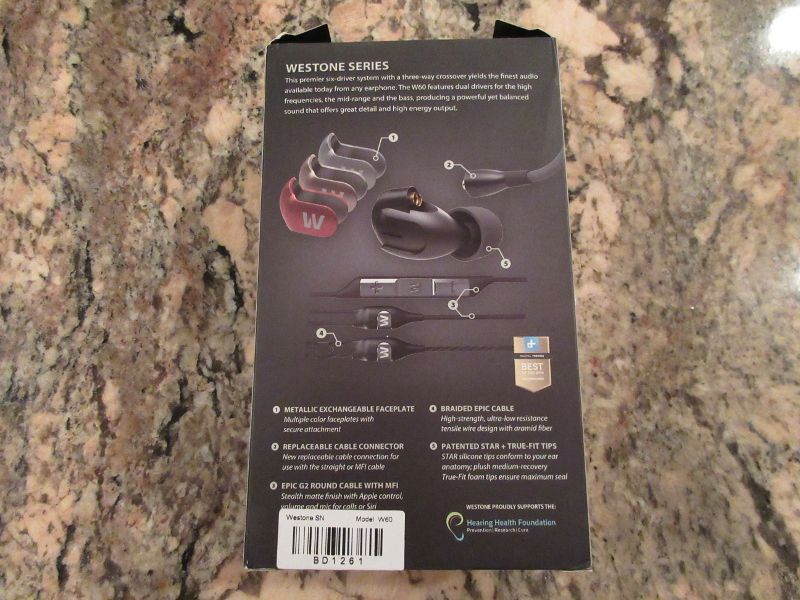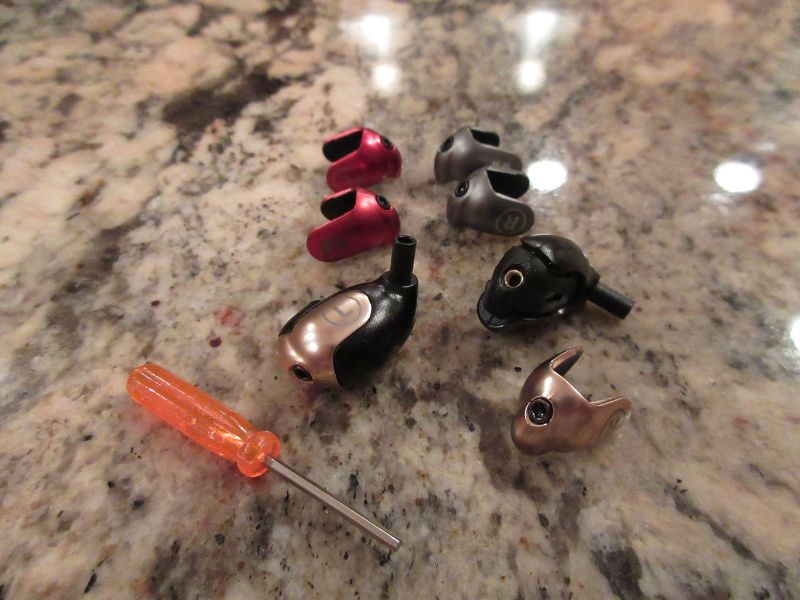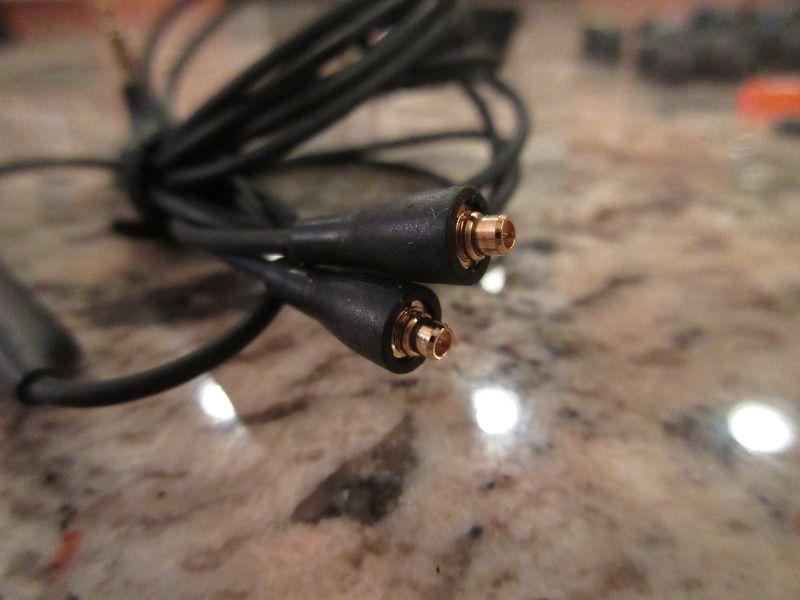twister6
Android Expert
This is a Review of Westone W60 Signature Series 6-driver in-ear monitors (IEMs). http://www.westoneaudio.com/index.php/products/w-series/westone-w60.html, also available on amazon: http://www.amazon.com/Westone-W60-Signature-Universal-fit-Headphones/dp/B00KQOZA1Y/?tag=vectron00-20
In a world of premium multi-driver $500+ IEMs, it often comes down to how drivers are grouped between lows/mids/highs, how they are tuned according to this partitioning and crossover implementation, and how the additional drivers affect the size, the build, and the ergonomics of IEM housing design. Based on all these factors, one can determine which pair suites their taste and budget better when you finally ready to step into the world of top of the line (TOTL) headphones.
After a number of my previous Westone IEM reviews covering W40, UM Pro 30, and UM Pro 50, I'm finally ready to explore the crown of their W-series line up - W60 model with six Balanced Armature (BA) drivers partitioned into pairs covering each band of low, mid, and high frequencies. As a bonus, considering a number of requests after my UM Pro 50 review, I will also go into a more detailed comparison between W60, UM Pro 50, and Shure SE846. Though SE846 is only 4-driver design, Shure positioned its flagship $1k pair at TOTL level which should go head-to-head with $1k pair of W60. Might as well call it a battle of $1k IEMs! So without further ado, let me begin.
I always start my reviews with a description of the packaging and virtual unboxing. Looking at W60 box, you are greeted with an outer sleeve featuring a high-res image of Westone flagship on the front side. The look of the cover has the same layout as W40 but "W" logo is now in silver and there is a "Signature Series" label above the model number. On the back and the sides of the sleeve you have a detailed description of the design, accessories, and tech specs. You definitely get an in-depth picture of what awaits you inside. With an outer sleeve off, you are presented with a premium soft touch magnetic cover inner box which contains headphones and plethora of the accessories.
I have to admit, the amount and the quality of included custom accessories is very impressive for the first time Westone customer, but it could leave you a bit disappointed if you are upgrading to W60 from any of their lower model, even as basic as a single driver W10, since there is no premium accessory distinction. Seems that with accessories Westone made a conscious decision where every W-series customer can feel special, either if you spent $200 for their single driver or $1k for their 6-driver pair of headphones, with nearly an identical package including their 5 patented pairs of Star silicone eartips, 5 pairs of True-Fit foam eartips, 3 sets of interchangeable color faceplates (in case of W60 they have standout color/finish), mini monitor-vault case, and 2 sets of Epic audio and MFI G2 smartphone cables with mmcx connectors.
I already mentioned in my previous reviews that I believe Westone has a definite advantage over other IEM manufacturers because they have been in audio business for over 55 years and have a full catalog of not only professional audio but also hearing protection products. As a result, don’t expect to find a typical generic S/M/L eartips or a pair of Comply tips in a plastic bag. With a color coded marked stems, Star silicone tips are designed with multiple flex-zones and have 5 pairs in different length, shape, and size. The same with True-Fit foam tips, you get 5 pairs with color coded stems and shapes similar to Star tips. Their foam density has a medium recovery property - not too soft or too firm. You also get a cleaning tool with a small metal loop to clean inside of a narrow nozzle or eartip stems, and a pelican style small “vault” storage case. This case is OK to use with included thin flexible cable, but if you decide to go with a thicker aftermarket cable – you will need to step up to a bigger case.
Unboxing and Accessories.






As part of their W-series “consumer” appeal, Westone also adds an option of customizable interchangeable faceplates. With W60 they made faceplate colors different from other lower models, giving them a more premium look with included red/silver/copper metallic finish plates. Plates are actually plastic but have a metal color finish which still keeps it lightweight and durable without adding extra weight to the shell. Also, with an included small screwdriver tool they are very easy to take off and secure back on, and you don’t have to worry about losing a screw which stays with a faceplate.
Exchangeable faceplates.

Included removable cables give you an option of either audio only Epic twisted cable or MFI G2 cable with in-line remote for smartphones. Epic cable is thin, lightweight, and flexible, with ultra low resistance tensile wire design reinforced with aramid fiber. For a stock cable it actually has a decent audio performance. G2 cable has a more robust rounded shielding, still soft and flexible, and comes with in-line remote/mic. Though multi-function button is OS independent and can be used for Play/Pause/Call, the volume up/down buttons are for iOS only operation. Westone offers a similar cable (Android version) with universal remote where volume buttons are removed to eliminate the confusion. In my opinion, the remote could have been smaller and I would keep it universal with a single multi-function button covering both Android and iOS smartphones. Personally, I’m a big fan of aftermarket audio cables, such as pure silver or pure copper, but they do come at a premium price and heavier weight. Either way, removable cable option is a big plus and gives you flexibility of future upgrades.
One thing you do have to keep in mind, something a lot of people don’t realize, is about the size of Westone mmcx connectors. It is true that Westone uses common mmcx type, but these are short profile connectors, not a standard size. As a result, you can use any mmcx based universal cable with Westone (new W-series or UM-series) IEMs, but you will not be able to use their Epic or G2 cable with other mmcx connector based IEMs, such as those from UE, JVC, Fidue, and others. For that reason, when you are looking into replacement custom cables, I would recommend to specify universal mmcx connector rather than W60 specific connector.
Cables (EPIC G2 round cable w/MFI and EPIC braided audio cable).







When it comes to a design, Westone bean-shaped shells are among the most comfortable universal fit IEMs I have tested. I think it’s another example of how they have an advantage over competition while drawing from a pool of their knowledge and experience of designing ergonomic hearing protection products. These headphone shells have a very stick and lightweight rounded design, and the most important – they stay the same size regardless of driver config, with an exception of W10/W20 being slightly smaller. Westone model index is based on a number of drivers, where W10 or UM Pro 10 correspond to a single BA driver, while 20/30/40/50/60 represent up to 6 BA drivers per shell. It's quite possible they take advantage of combined BA driver modules to reduce number of components, and I can confirm there is no difference in size or shape going from 4-driver W40 to 6-driver W60.
Unlike UM Pro series offered in clear and smoke translucent shells, W-series is non-transparent, made out of black lightweight durable plastic, and customizable with interchangeable faceplates that come handy when you mix the colors to distinguish L/R sides, perhaps using Red plate on a right side. That’s how I have it on W40, but I really enjoyed the copper color of W60 plates which adds a premium look to these IEMs. Another point to make, something that already came up in questions after my W40 review, the shell joint around mmcx connector housing is not cracked! Some people freak out and go into panic mode thinking they applied too much force when disconnecting the cable, causing it to crack, while in reality it’s just a joint gap intended by a design.
The shape and fitment of Westone IEMs is not symmetrical, so there is no confusion which piece goes into which ear, and for further guidance faceplates also have a large L/R letter for a better id. The wire fitment is always over the ear, it’s very comfortable and produces no microphonics even when cable is rubbing against your cloth. There is no visible pinhole port to let the air in/out of the shell, while sound still remains very spacious. Nozzle is very narrow, corresponding to T100 Comply size, and I never experienced a problem of leaving an eartip behind when earpieces removed from my ears, though I do have to admit I typically use the largest size tips.
In a world of premium multi-driver $500+ IEMs, it often comes down to how drivers are grouped between lows/mids/highs, how they are tuned according to this partitioning and crossover implementation, and how the additional drivers affect the size, the build, and the ergonomics of IEM housing design. Based on all these factors, one can determine which pair suites their taste and budget better when you finally ready to step into the world of top of the line (TOTL) headphones.
After a number of my previous Westone IEM reviews covering W40, UM Pro 30, and UM Pro 50, I'm finally ready to explore the crown of their W-series line up - W60 model with six Balanced Armature (BA) drivers partitioned into pairs covering each band of low, mid, and high frequencies. As a bonus, considering a number of requests after my UM Pro 50 review, I will also go into a more detailed comparison between W60, UM Pro 50, and Shure SE846. Though SE846 is only 4-driver design, Shure positioned its flagship $1k pair at TOTL level which should go head-to-head with $1k pair of W60. Might as well call it a battle of $1k IEMs! So without further ado, let me begin.
I always start my reviews with a description of the packaging and virtual unboxing. Looking at W60 box, you are greeted with an outer sleeve featuring a high-res image of Westone flagship on the front side. The look of the cover has the same layout as W40 but "W" logo is now in silver and there is a "Signature Series" label above the model number. On the back and the sides of the sleeve you have a detailed description of the design, accessories, and tech specs. You definitely get an in-depth picture of what awaits you inside. With an outer sleeve off, you are presented with a premium soft touch magnetic cover inner box which contains headphones and plethora of the accessories.
I have to admit, the amount and the quality of included custom accessories is very impressive for the first time Westone customer, but it could leave you a bit disappointed if you are upgrading to W60 from any of their lower model, even as basic as a single driver W10, since there is no premium accessory distinction. Seems that with accessories Westone made a conscious decision where every W-series customer can feel special, either if you spent $200 for their single driver or $1k for their 6-driver pair of headphones, with nearly an identical package including their 5 patented pairs of Star silicone eartips, 5 pairs of True-Fit foam eartips, 3 sets of interchangeable color faceplates (in case of W60 they have standout color/finish), mini monitor-vault case, and 2 sets of Epic audio and MFI G2 smartphone cables with mmcx connectors.
I already mentioned in my previous reviews that I believe Westone has a definite advantage over other IEM manufacturers because they have been in audio business for over 55 years and have a full catalog of not only professional audio but also hearing protection products. As a result, don’t expect to find a typical generic S/M/L eartips or a pair of Comply tips in a plastic bag. With a color coded marked stems, Star silicone tips are designed with multiple flex-zones and have 5 pairs in different length, shape, and size. The same with True-Fit foam tips, you get 5 pairs with color coded stems and shapes similar to Star tips. Their foam density has a medium recovery property - not too soft or too firm. You also get a cleaning tool with a small metal loop to clean inside of a narrow nozzle or eartip stems, and a pelican style small “vault” storage case. This case is OK to use with included thin flexible cable, but if you decide to go with a thicker aftermarket cable – you will need to step up to a bigger case.
Unboxing and Accessories.






As part of their W-series “consumer” appeal, Westone also adds an option of customizable interchangeable faceplates. With W60 they made faceplate colors different from other lower models, giving them a more premium look with included red/silver/copper metallic finish plates. Plates are actually plastic but have a metal color finish which still keeps it lightweight and durable without adding extra weight to the shell. Also, with an included small screwdriver tool they are very easy to take off and secure back on, and you don’t have to worry about losing a screw which stays with a faceplate.
Exchangeable faceplates.

Included removable cables give you an option of either audio only Epic twisted cable or MFI G2 cable with in-line remote for smartphones. Epic cable is thin, lightweight, and flexible, with ultra low resistance tensile wire design reinforced with aramid fiber. For a stock cable it actually has a decent audio performance. G2 cable has a more robust rounded shielding, still soft and flexible, and comes with in-line remote/mic. Though multi-function button is OS independent and can be used for Play/Pause/Call, the volume up/down buttons are for iOS only operation. Westone offers a similar cable (Android version) with universal remote where volume buttons are removed to eliminate the confusion. In my opinion, the remote could have been smaller and I would keep it universal with a single multi-function button covering both Android and iOS smartphones. Personally, I’m a big fan of aftermarket audio cables, such as pure silver or pure copper, but they do come at a premium price and heavier weight. Either way, removable cable option is a big plus and gives you flexibility of future upgrades.
One thing you do have to keep in mind, something a lot of people don’t realize, is about the size of Westone mmcx connectors. It is true that Westone uses common mmcx type, but these are short profile connectors, not a standard size. As a result, you can use any mmcx based universal cable with Westone (new W-series or UM-series) IEMs, but you will not be able to use their Epic or G2 cable with other mmcx connector based IEMs, such as those from UE, JVC, Fidue, and others. For that reason, when you are looking into replacement custom cables, I would recommend to specify universal mmcx connector rather than W60 specific connector.
Cables (EPIC G2 round cable w/MFI and EPIC braided audio cable).







When it comes to a design, Westone bean-shaped shells are among the most comfortable universal fit IEMs I have tested. I think it’s another example of how they have an advantage over competition while drawing from a pool of their knowledge and experience of designing ergonomic hearing protection products. These headphone shells have a very stick and lightweight rounded design, and the most important – they stay the same size regardless of driver config, with an exception of W10/W20 being slightly smaller. Westone model index is based on a number of drivers, where W10 or UM Pro 10 correspond to a single BA driver, while 20/30/40/50/60 represent up to 6 BA drivers per shell. It's quite possible they take advantage of combined BA driver modules to reduce number of components, and I can confirm there is no difference in size or shape going from 4-driver W40 to 6-driver W60.
Unlike UM Pro series offered in clear and smoke translucent shells, W-series is non-transparent, made out of black lightweight durable plastic, and customizable with interchangeable faceplates that come handy when you mix the colors to distinguish L/R sides, perhaps using Red plate on a right side. That’s how I have it on W40, but I really enjoyed the copper color of W60 plates which adds a premium look to these IEMs. Another point to make, something that already came up in questions after my W40 review, the shell joint around mmcx connector housing is not cracked! Some people freak out and go into panic mode thinking they applied too much force when disconnecting the cable, causing it to crack, while in reality it’s just a joint gap intended by a design.
The shape and fitment of Westone IEMs is not symmetrical, so there is no confusion which piece goes into which ear, and for further guidance faceplates also have a large L/R letter for a better id. The wire fitment is always over the ear, it’s very comfortable and produces no microphonics even when cable is rubbing against your cloth. There is no visible pinhole port to let the air in/out of the shell, while sound still remains very spacious. Nozzle is very narrow, corresponding to T100 Comply size, and I never experienced a problem of leaving an eartip behind when earpieces removed from my ears, though I do have to admit I typically use the largest size tips.
Last edited:














